THE 2018 Soccer World Cup will be played in the Russia. What do we know about this country? What are its geographic characteristics? This text will cover geographic information about the host cities of the World Cup matches.
host cities
To host the World Cup matches, Russia has prepared twelve stadiums distributed in eleven host cities:
- Kaliningrad
- Kazan
- Moscow (2 stadiums)
- Nizhny Novgorod
- Rostov
- Saint Petersburg
- Samara
- Saransk
- Sochi
- Volgograd
- Yekaterinburg
→ Moscow
The city of Moscow is characterized as a space in a constant process of modernization, with the mixture between the most characteristic elements of the current stage of urban development and the historical elements that refer to the period of Cold War.
Moscow is home to the country's political-administrative center, in a portion of the territory called the Kremlin. The climate in Moscow is predominantly cold, with well-established seasons. Rainfall rates are high, and the city has low thermal range between the months of the year.

St. Isaac's Square is one of the sights of St. Petersburg
Credit: olgysha / Shutterstock
The city of St. Petersburg is located in northwestern Russia. With a more rigorous climate than Moscow and Sochi, due to its longitudinal position further north, temperatures vary between - 4ºC and 15ºC between the coldest and hottest periods of the year.
The strong economic potential in the naval industry segment stands out in St. Petersburg, with the construction of ships and other vessels. The city is also home to important mechanical, chemical, petrochemical and pharmaceutical complexes, making it one of the main industrial and commercial centers in Russia.
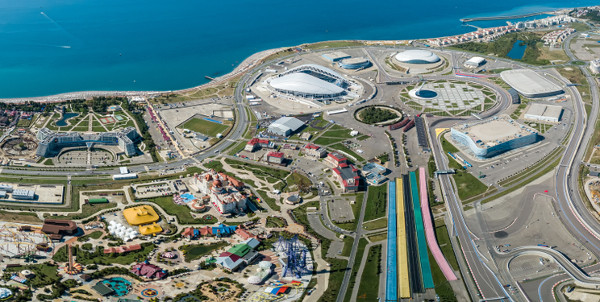
Sochi Stadium is in the 2014 Winter Olympics Olympic Park
Credit: Maykova Galina / Shutterstock
The city of Sochi is located in southwestern Russia, on the shores of the Black Sea. With milder temperatures than the rest of the Russian territory, the city has been gaining the interest of Russians who want alternatives to the country's cold climate. The interest of visitors to the city has consolidated it as a center of attraction for people and investments, who saw in the city an opportunity for profits associated with sporting and commercial tourism. The city began to host major events in recent years, such as the Winter Olympics, Confederations Cup, Formula I races, among others.
→ Rostov

Rostov is located on the banks of the River Don
Credit: Maykova Galina / Shutterstock
The city of Rostov is located in southern Russia, on the banks of the River Don. It is the administrative capital of a Russian federal district of the same name. Also known as Rostov-do-Don, the city has an estimated population of 1,100,000 inhabitants.
Occupying Russia's lowest latitude, the city of Rostov has one of the highest average temperatures in the country, around 10°C. The hottest month of the year is July, when temperatures approach 24ºC. The coldest period of the year is January, when temperatures drop to -4.2°C.
The city's commerce developed from agriculture, food processing and heavy industry. Recently, together with the city of Bataysk, it became a hub for the Russian arms industry, producing helicopters and equipment for these aircraft.
→ Kaliningrad

Kaliningrad is isolated from the rest of Russia
Credit: Konstantin Tronin / Shutterstock
The city of Kaliningrad is a Russian exclave, that is, a territory completely separated from Russia, situated on the border between Poland and Lithuania. This territory has 15,100 km² and a population close to one million inhabitants.
The fact that it is an extension of Russian territory, but totally disconnected from the mainland country, generates a feeling of non-belonging between those who live in Kalingrad, who find themselves much closer to the European Union than to Moscow, which is about 1258 km.
→ Kazan
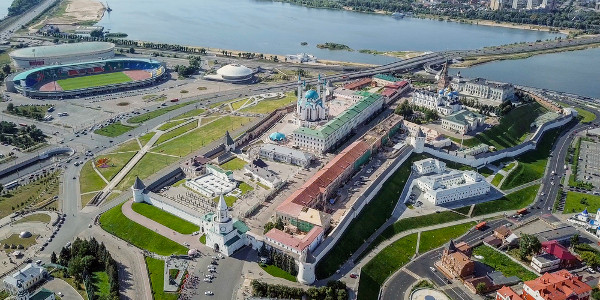
Aerial view of Kazan Kremlin
Credit: Maykova Galina / Shutterstock
The city of Kazan is located in the central portion of Western Russia and is approximately 825 km from the capital, Moscow. It is considered the third most important city in Russia and is also the capital of Tatarstan, an autonomous republic of Russia (equivalent to a state in Brazil).
known as the most Islamic city in Russia, the city of Kazan stands out for its religious pluralism and peaceful coexistence between the various religions.
→ Volgograd
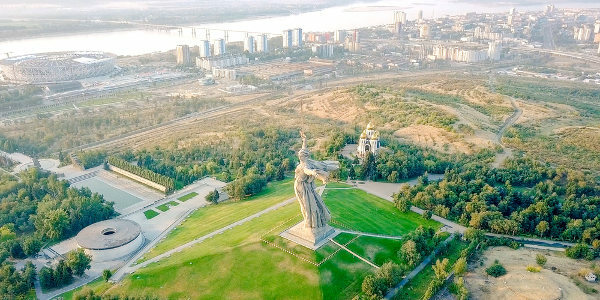
Hand Sculpture and the city of Volgograd in the background
Credit: Maykova Galina / Shutterstock
The city of Volgograd is located on the banks of the Volga River, in the Russian portion between Ukraine and Kazakhstan. Its territorial extension is approximately 860 km², and its population has just over one million inhabitants.
The city's name is a derivation of the name of the Volga River, which runs through it. The most curious fact about this city was the name changes it received over the last century. Initially, the city was known as Tsaritsin. In 1925, the city was renamed to honor the Soviet leader Joseph Stalin, renamed Stalingrad. In 1961, it was renamed Volgograd.
→ Samara
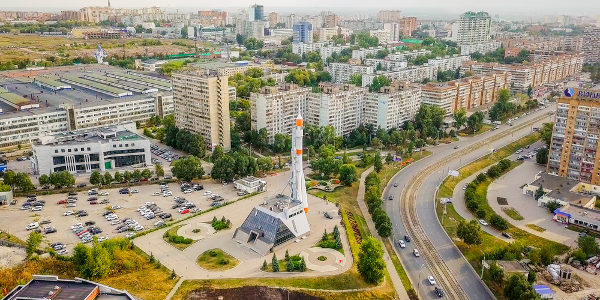
City of Samara has in Aerospace Museum
Credit: Maykova Galina / Shutterstock
The city of Samara is located in southwestern Russia, near Kazakhstan, on the banks of the Volga River. Its distance from the capital Moscow is 1,068 km.
With a population of approximately 1.14 million inhabitants, the city of Samara is considered the main aerospace center in Russia. The Vostok spacecraft departed from the city, carrying the first man on board to make a space trip – the Russian Yuri Gagarin. Another curiosity of the city of Samara is that it houses the largest square in Europe, the Kuybychev square, with 174,000 m².
→ Yekaterinburg

Ekaterinburg Stadium has a capacity of 45 thousand people
Credit: Maykova Galina / Shutterstock
Yekaterinburg is situated on the border of Europe and Asia, 1,667 km east of Moscow, in the eastern portion of the Ural Mountains, over the Iset River. It has approximately 1.4 million inhabitants, spread over an area of 468 km². The city is also known as the “Window to Asia” and is also the host city for the World Cup furthest away from Moscow.
The main historical fact that marked the city was the family murder Romanov, to which Tsar Nicholas II belonged. After the failure of the war against Japan and the fall of the tsar, he and his family were forced to take refuge in Yekaterinburg under the pretext of protection against popular insurrections. In the early hours of July 17, 1918, Red Army officers, at the behest of leader Vladmir Lenin, broke into the house and shot everyone. In the place, as a tribute, the "Church of Blood" was built, as the main icon of Yekaterinburg is known. The entire Romanov family was canonized by the Orthodox Church.
→ Saransk
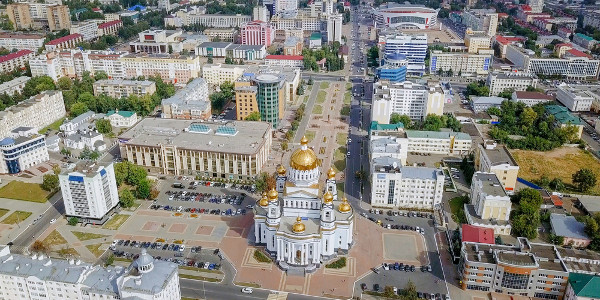
Saransk Cathedral is one of the city's sights.
Saransk is the capital of the Republic of Mordovia. It is located in the watershed of the Volga River, on the banks of the Saranka and Insar rivers, at a distance of approximately 630 km east of Moscow. The city has an area of 71.5 km² and an estimated population of 300,000 inhabitants.
A curious fact observed in the city of Saransk refers to its population reduction, resulting from migratory movements after the end of the USSR. During the golden period of the Socialist Republic, the city received large investments and became an important center for the production of military material. After fall of the ussr, large industries became obsolete and many were deactivated. Thus, there was a reversal of the migratory flow, now focusing on other regions with greater potential for income and employability, causing a decrease in population in the city.
→ Nizhny Novgorod

Stadium in Nizhny Novgorod was built to host 45,000 fans
Credit: Leni Kovaleva / Shutterstock
Nizhny Novgorod is a city in Russia situated on the banks of the Volga and Oka rivers. It has about 1.3 million inhabitants, spread over an area of 460 km².
The city of Nizhny Novgorod was important to the USSR regime because of the development of research related to nuclear weapons during the Cold War. The city was heavily guarded and foreigners were not allowed in.
by Hugo Mota
Graduated in Geography
Source: Brazil School - https://brasilescola.uol.com.br/educacao-fisica/cidades-sede-copa-mundo-na-russia-2018.htm

